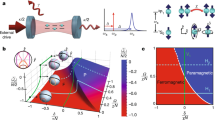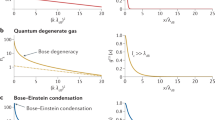Abstract
We propose that condensed-matter phenomena involving the spontaneous emergence and dynamics of crystal lattices can be realized using Bose–Einstein condensates coupled to multimode optical cavities. It is known that, in the case of a transversely pumped single-mode cavity, the atoms crystallize at either the even or the odd antinodes of the cavity mode at sufficient pump laser intensity, thus spontaneously breaking a discrete translational symmetry. Here we demonstrate that, in multimode cavities, crystallization involves the spontaneous breaking of a continuous translational symmetry, through a variant of Brazovskii’s transition, thus paving the way for realizations of compliant lattices and associated phenomena, such as dislocations, frustration, glassiness and even supersolidity, in ultracold atomic settings, where quantum effects have a dominant role. We apply a functional-integral formalism to explore the role of fluctuations in this correlated many-body system, to calculate their effect on the threshold for ordering, and to determine their imprint on the correlations of the light emitted from the cavity.
This is a preview of subscription content, access via your institution
Access options
Subscribe to this journal
Receive 12 print issues and online access
$209.00 per year
only $17.42 per issue
Buy this article
- Purchase on Springer Link
- Instant access to full article PDF
Prices may be subject to local taxes which are calculated during checkout



Similar content being viewed by others
References
Kim, E. & Chan, M. H. W. Observation of superflow in solid helium. Science 305, 1941–1944 (2004).
Domokos, P. & Ritsch, H. Collective cooling and self-organization of atoms in a cavity. Phys. Rev. Lett. 89, 253003 (2002).
Asboth, J. K., Domokos, P., Ritsch, H. & Vukics, A. Self-organization of atoms in a cavity field: Threshold, bistability, and scaling laws. Phys. Rev. A 72, 053417 (2005).
Lewenstein, M. et al. in Proc. of ICAP Innsbruck (eds Roos, C. F., Häffner, H. & Blatt, R.) 201–211 (AIP Conf. Proc. No. 869, AIP, 2006).
Nagy, D., Szirmai, G. & Domokos, P. Self-organization of a Bose–Einstein condensate in an optical cavity. Eur. Phys. J. D 48, 127–137 (2008).
Black, A. T., Chan, H. W. & Vuletic, V. Observation of collective friction forces due to spatial self-organization of atoms: From Rayleigh to Bragg scattering. Phys. Rev. Lett. 91, 203001 (2003).
Vuletic, V. & Chu, S. Laser cooling of atoms, ions, or molecules by coherent scattering. Phys. Rev. Lett. 84, 3787–3790 (2000).
Lev, B. L. et al. Prospects for the cavity-assisted laser cooling of molecules. Phys. Rev. A 77, 023402 (2008).
Nagy, D., Asboth, J. K., Domokos, P. & Ritsch, H. Self-organization of a laser-driven cold gas in a ring cavity. Europhys. Lett. 74, 254–260 (2006).
Brazovskii, S. Phase transition of an isotropic system to an inhomogenous state. Zh. Eksp. Teor. Fiz. 68, 175–185 (1975) (Sov. Phys. JETP 41, 85–89 (1975)).
Góral, K., Santos, L. & Lewenstein, M. Quantum phases of dipolar bosons in optical lattices. Phys. Rev. Lett. 88, 170406 (2002).
Yi, S., Li, T. & Sun, C. P. Novel quantum phases of dipolar Bose gases in optical lattices. Phys. Rev. Lett. 98, 260405 (2007).
Walls, D. F. & Milburn, G. J. Quantum Optics (Springer, 2008).
Hadzibabic, Z., Krüger, P., Cheneau, M., Battelier, B. & Dalibard, J. Berezinskii–Kosterlitz–Thouless crossover in a trapped atomic gas. Nature 441, 1118–1121 (2006).
Abrikosov, A., Gorkov, L. P. & Dzyaloshinski, I. E. Methods of Quantum Field Theory in Statistical Physics (Dover, 1975).
Keldysh, L. V. Diagram technique for nonequilibrium processes. Sov. Phys. JETP 20, 1018–1025 (1965).
Kamenev, A. & Levchenko, A. Keldysh technique and nonlinear sigma-model: Basic principles and applications. Adv. Phys. 58, 197–319 (2009).
Lifshitz, E. M. & Pitaevskii, L. P. Statistical Physics, Part 2 (Course of Theoretical Physics, Vol. 9, Pergamon, 1980).
Alexander, S. & McTague, R. Should all crystals be bcc? Landau theory of solidification and crystal nucleation. Phys. Rev. Lett. 41, 702–705 (1978).
Siegman, A. E. Lasers (University Science Books, 1986).
Leibler, L. Theory of microphase separation in block copolymers. Macromolecules 13, 1602–1617 (1980).
Swift, J. & Hohenberg, P. C. Hydrodynamic fluctuations at the convective instability. Phys. Rev. A 15, 319–328 (1977).
Hohenberg, P. C. & Swift, J. B. Metastability in fluctuation-driven first-order transitions: Nucleation of lamellar phases. Phys. Rev. E 52, 1828–1845 (1995).
Murch, K. W., Moore, K. L., Gupta, S. & Stamper-Kurn, D. M. Observation of quantum-measurement backaction with an ultracold atomic gas. Nature Phys. 4, 561–564 (2008).
Altman, E., Demler, E. & Lukin, M. D. Probing many-body correlations of ultra-cold atoms via noise correlations. Phys. Rev. A. 70, 013603 (2004).
Horak, P. et al. Optical kaleidoscope using a single atom. Phys. Rev. Lett. 88, 043601 (2002).
Salzburger, T., Domokos, P. & Ritsch, H. Enhanced atom capturing in a high-Q cavity by help of several transverse modes. Opt. Express 10, 1204–1214 (2002).
Acknowledgements
This work was supported by NSF PHY08-47469 (B.L.L.), AFOSR FA9550-09-1-0079 (B.L.L.), DOE DE-FG02-07ER46453 (S.G.) and NSF DMR09-06780 (P.M.G.). P.M.G. gratefully acknowledges the hospitality of the Aspen Center for Physics.
Author information
Authors and Affiliations
Contributions
All authors contributed equally to this work.
Corresponding author
Supplementary information
Supplementary Information
Supplementary Information (PDF 430 kb)
Rights and permissions
About this article
Cite this article
Gopalakrishnan, S., Lev, B. & Goldbart, P. Emergent crystallinity and frustration with Bose–Einstein condensates in multimode cavities. Nature Phys 5, 845–850 (2009). https://doi.org/10.1038/nphys1403
Received:
Accepted:
Published:
Issue Date:
DOI: https://doi.org/10.1038/nphys1403
This article is cited by
-
An optical lattice with sound
Nature (2021)
-
Observation of Laughlin states made of light
Nature (2020)
-
Topological soliton-polaritons in 1D systems of light and fermionic matter
Communications Physics (2019)
-
Dicke Quantum Phase Transition for a Bose-Einstein Condensate in a Two-Mode Optical Cavity
International Journal of Theoretical Physics (2019)
-
A strongly interacting polaritonic quantum dot
Nature Physics (2018)



